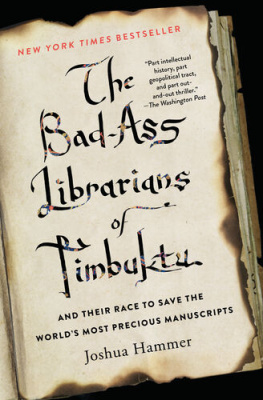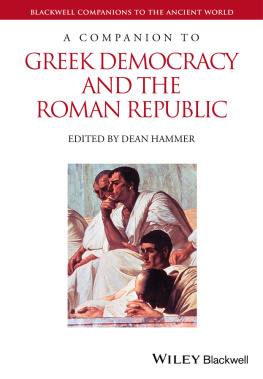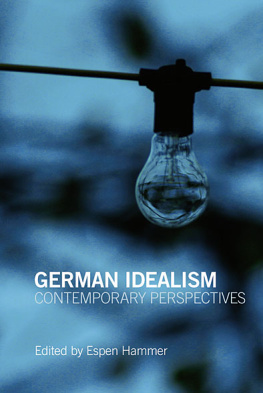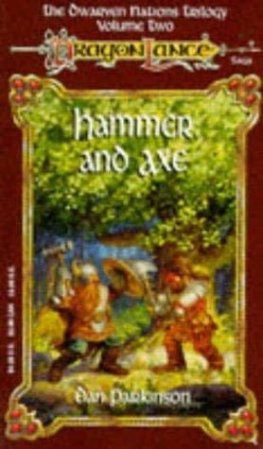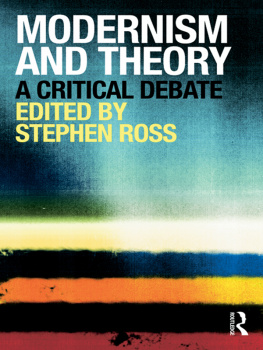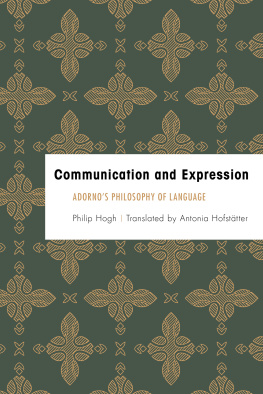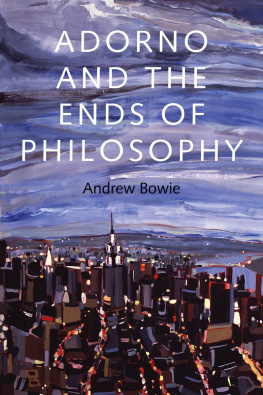Hammer - Adornos Modernism: Art, Experience, and Catastrophe
Here you can read online Hammer - Adornos Modernism: Art, Experience, and Catastrophe full text of the book (entire story) in english for free. Download pdf and epub, get meaning, cover and reviews about this ebook. year: 2015, publisher: Cambridge Univ Pr, genre: Religion. Description of the work, (preface) as well as reviews are available. Best literature library LitArk.com created for fans of good reading and offers a wide selection of genres:
Romance novel
Science fiction
Adventure
Detective
Science
History
Home and family
Prose
Art
Politics
Computer
Non-fiction
Religion
Business
Children
Humor
Choose a favorite category and find really read worthwhile books. Enjoy immersion in the world of imagination, feel the emotions of the characters or learn something new for yourself, make an fascinating discovery.
Adornos Modernism: Art, Experience, and Catastrophe: summary, description and annotation
We offer to read an annotation, description, summary or preface (depends on what the author of the book "Adornos Modernism: Art, Experience, and Catastrophe" wrote himself). If you haven't found the necessary information about the book — write in the comments, we will try to find it.
Adornos Modernism: Art, Experience, and Catastrophe — read online for free the complete book (whole text) full work
Below is the text of the book, divided by pages. System saving the place of the last page read, allows you to conveniently read the book "Adornos Modernism: Art, Experience, and Catastrophe" online for free, without having to search again every time where you left off. Put a bookmark, and you can go to the page where you finished reading at any time.
Font size:
Interval:
Bookmark:

Adornos Modernism
Theodor W. Adornos aesthetics has dominated discussions about art and aesthetic modernism since World War ii , and continues to inform contemporary theorizing. Situating Adornos aesthetic theory in the context of post-Kantian European philosophy, Espen Hammer explores Adornos critical view of art as engaged in reconsidering fundamental features of our relation to nature and reality. His book is structured around what Adorno regarded as the contemporary aestheticians overarching task: to achieve a vision of the fate of art in the modern world, while demonstrating its unique cognitive potential. Hammer offers a lively examination of Adornos work through the central problem of what full human self-actualization would require, and also discusses the wider philosophical significance of aesthetic modernism. This book will be a valuable resource for scholars and students of social philosophy, art, and aesthetics.
Espen Hammer is Professor of Philosophy at Temple University, Philadelphia. He has published many essays and books, including Stanley Cavell: Skepticism, Subjectivity, and the Ordinary (2002), Adorno and the Political (2006), Philosophy and Temporality from Kant to Critical Theory (Cambridge, 2011), and The Routledge Handbook of the Frankfurt School (co-edited with Axel Honneth and Peter Gordon, forthcoming, 2016), and is the editor of German Idealism: Contemporary Perspectives (2007).
Adornos Modernism
Art, Experience, and Catastrophe
Espen Hammer


University Printing House, Cambridge cb 2 8 bs , United Kingdom
Cambridge University Press is part of the University of Cambridge.
It furthers the Universitys mission by disseminating knowledge in the pursuit of education, learning, and research at the highest international levels of excellence.
www.cambridge.org
Information on this title: www.cambridge.org/9781107121591
Espen Hammer 2015
This publication is in copyright. Subject to statutory exception and to the provisions of relevant collective licensing agreements, no reproduction of any part may take place without the written permission of Cambridge University Press.
First published 2015
A catalogue record for this publication is available from the British Library
Library of Congress Cataloguing in Publication data
Hammer, Espen.
Adornos modernism : art, experience, and catastrophe / Espen Hammer.
pages cm
Includes bibliographical references and index.
ISBN 978-1-107-12159-1 (hbk)
1. Adorno, Theodor W., 19031969. 2. Modernism (Aesthetics) I. Title.
B 3199. A 34 H 36 2015
111.85092dc23 2015014246
ISBN 978-1-107-12159-1 hardback
Cambridge University Press has no responsibility for the persistence or accuracy of URL s for external or third-party internet websites referred to in this publication, and does not guarantee that any content on such websites is, or will remain, accurate or appropriate.
In the first two or three decades after World War ii , as intellectuals were struggling to come to terms with what had happened and assess the cultural and political situation in Europe, Theodor W. Adorno became a towering figure in German philosophy and aesthetics. Like his colleagues in the Frankfurt School, Adorno argued that the catastrophe of the Nazi years represented a historical caesura: from now on, it was thought, it was impossible to just continue, as though the collapse of civilization were a limited national aberration allowing some kind of eventual return to normalcy. There was a sense that everything had to be radically rethought philosophy, politics, codes of behavior, as well as art and culture in the widest sense. Adorno famously gave expression to this sentiment when, in 1951, he stated that writing poetry after Auschwitz is barbaric. In the high modernism of artists like Schnberg and Beckett, he found models for how art could nevertheless respond to this predicament, and Adornos approach became emblematic of the period and came to dominate aesthetic reflection in Europe at least until the 1980s.
In the 1980s, well over a decade after his death, Adornos reputation as a cultural icon, a public voice of conscience of the kind that Jean-Paul Sartre had been in France, started to wane, and with the rise of postconceptual art and postmodern theory, his modernist commitments grounded in complicated dialogues with Kant and Hegel began to seem less relevant. During the same period, Jrgen Habermas made a big impact with his communication-theoretic reformulation of the foundations of Critical Theory. According to Habermas, while Adornos thinking had been of tremendous significance for the postwar generation, he had failed to take the required step beyond the so-called philosophy of consciousness and, especially in his aesthetics, had been flirting with mysticism. In the German Wellmers hypothesis was that many of Adornos intuitions could be preserved if formulated in different philosophical terms. However, exactly how much of Adornos aesthetics would be left if transposed to a Habermasian, communication-theoretic register was never made entirely clear.
Over the last three decades or so, an increasing number of interpretations have appeared in English that treat Adorno not simply as a cultural critic but also as providing an actual option for philosophy more broadly considered. Some of this work has been influenced by Habermass ideas. Other work, such as that of Fredric Jameson, has focused on Adornos Marxist commitments and tried to reclaim his legacy for the analysis of late capitalist culture. However, much of the most interesting reception has taken developments in Anglo-American analytic philosophy into account, interpreting Adorno in dialogue with figures such as Richard Rorty, Robert Brandom, and John McDowell.
In the early phase of the Anglo-American reception, the anthropology and the critique of civilization dominated the interpretations. Then, during the years of debate with the Habermasian paradigm, Adornos views of rationality and representation became central. There have certainly been pioneering attempts at reconstructing the aesthetics as well. In the early 1990s, responding to recent debates in Continental aesthetics, Jay Bernstein and Lambert Zuidervaart each produced important work dealing with central and systematic aspects of Adornos aesthetic edifice.continued the modernist legacy, the high modernist attention to aesthetic quality and detail has had to compete with a large number of conceptual and postconceptual art-practices.
My aim here is not to discuss contemporary art. Like Kant, Hegel, Schopenhauer, Nietzsche, and Heidegger, Adorno is one of the great classics of the European tradition of philosophical aesthetics. With that tradition as my primary context, I want to understand the philosophical implications of Adornos aesthetics. In particular, I seek to locate his discussion of art within the post-Kantian framework of understanding the nature and prospects of human freedom. However, I also explore the nature of aesthetic modernism its fundamental claims and commitments, its social and cultural conditions as it grew out of the post-Kantian tradition. Although the book largely proceeds historically, providing an interpretive reconstruction of Adornos aesthetics as it emerges in response especially to Kant and Hegel, it is not primarily intended as a historical contribution. Its overall aim is to demonstrate that this is a perfectly live option, combining, with an almost overwhelming degree of articulation and finesse, a critical account of modern social systems with a philosophically acute and uniquely sensitive approach to modernist art.
Font size:
Interval:
Bookmark:
Similar books «Adornos Modernism: Art, Experience, and Catastrophe»
Look at similar books to Adornos Modernism: Art, Experience, and Catastrophe. We have selected literature similar in name and meaning in the hope of providing readers with more options to find new, interesting, not yet read works.
Discussion, reviews of the book Adornos Modernism: Art, Experience, and Catastrophe and just readers' own opinions. Leave your comments, write what you think about the work, its meaning or the main characters. Specify what exactly you liked and what you didn't like, and why you think so.


